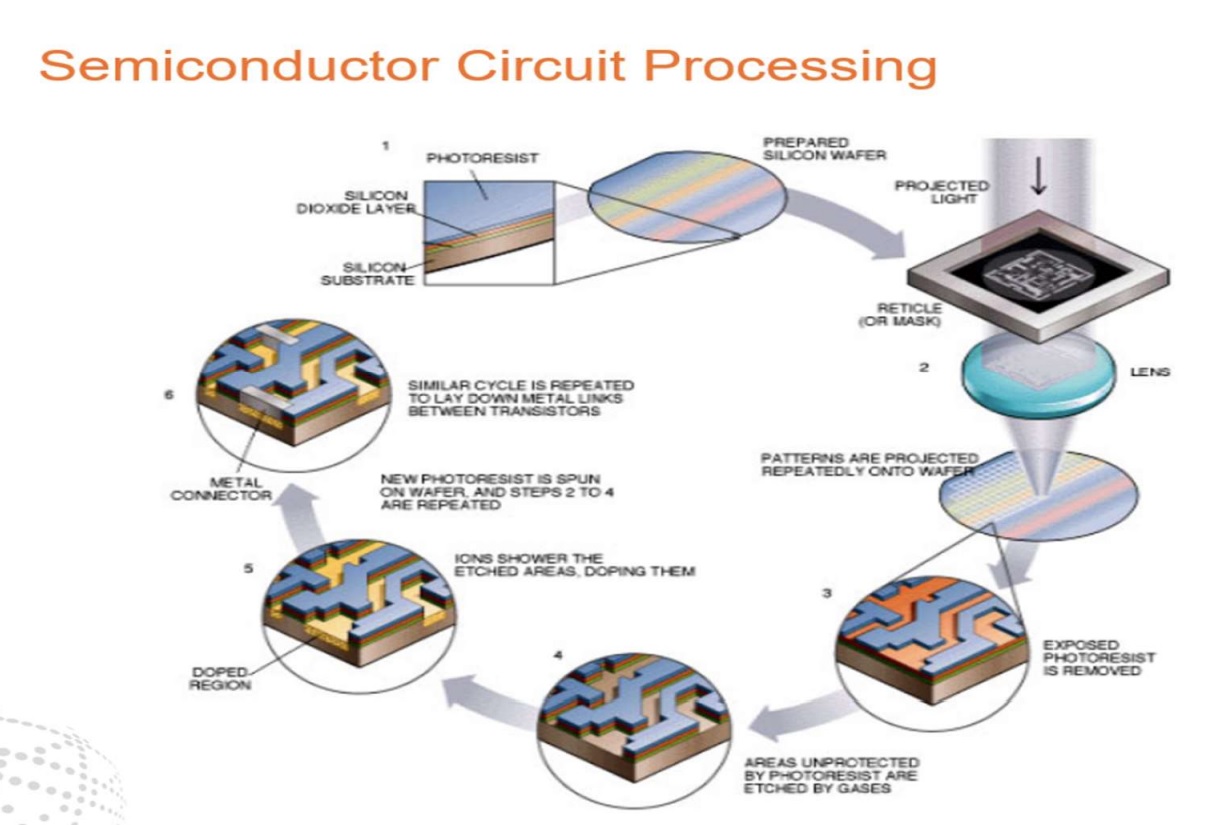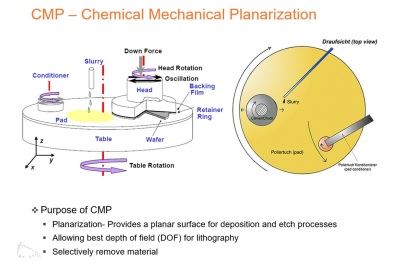NATIONAL POLLUTIOn pREVENTION rOUNDTABLE |
GlobalFoundries, Inc. (Essex Junction, VT)

The GlobalFoundries Vermont facility (FAB9) manufactures semiconductor chips for global telecommunications and consumer electronics markets. The following projects were driven by the team’s goals to improve tool utilization and increase process efficiency and become the best in class for ‘cost per wafer pass’ in the industry. All this while developing sustainable processes that are safe and healthful with reduced environmental impact.
Solvent Pre-Rinse Elimination: The Team discovered an older process running for one technology. For this technology, the process was rinsing the wafer with solvent prior to the application of photoresist to clean the wafer. This was a legacy process left over from many years prior, and this process had been instituted due to an upstream tool causing organic defects on the wafer surface. That upstream process had changed and the problem was resolved, but this process was not removed. The Team qualified the elimination of this solvent pre-rinse with no increase in defectivity or degradation off yield. This project reduced solvent usage by 16,304 liters and saved approximately $45,000 in chemical costs.
FSI Polaris 25% Pre-Wet Reduction: The goal was to reduce solvent use without impacting the process integrity and product quality and reliability. The work involved creating an extensive matrix, running, and evaluating the optimal solvent use against the key process parameters. There was an extensive qualification effort associated with this conversion which enabled the reduction of solvent used by 25% for a total of 5,606 liters annually and saved $91,930 in chemical costs.
The qualification effort encompassed all different substrate types coming to this group of tools and evaluating each one with product wafers. The team used a macro defect inspection tool tuned to find striations or missing photoresist, reviewed several thousand wafer images across incoming film or substrate types. Solvent for this fleet of tools is delivered to the tool in 10 Liter bottles, and this project eliminated 500 bottle changes per year on the tool set. The elimination of bottle changes reduced the need for chemical handling which removes contact risk exposure to the operators and the possibility for an accidental spill or release.
HD4004 Develop Solvent Reduction: Photo sensitive polyimide uses a solvent with high solubility as a developer for the photo process. This developer process also uses an additional solvent as a rinse agent. The project objective was to find the process window which allowed for significant reduction of the use of these solvents without changing the resultant developed polyimide structure. To ensure this process was equivalent to the process of record, the Team ran a matrix around volume of each chemical while doing both visual inspection of the wafer and its cross section. The resulting process exhibited equivalent results within acceptable process margins and achieved a 55% reduction of the highly soluble, higher cost developer solvent while reducing the rinse solvent by 36%. Overall, this project reduced over 40,000 liters of solvent usage which prevented this from becoming waste. In addition, this project saved $248,403 in chemical costs.
Blended Pre-Wet: FAB9 developed an innovative process to both reduce the amount of solvent used on a large subset of photo tools and significantly decreased the cost of solvent required for this process step. This process step is critical to the application of the photoresist on the wafer. The photoresist has to be applied defect free and at a uniformity across the wafer of less than 45 angstroms. The process is unique in the industry, it leverages a lower cost bulk chemical over a higher cost chemical that is delivered to the tool from a 10 Liter bottle that is resident on the tool. The overall process reduced the volume of solvent used on the wafer by 25% while reducing the higher cost chemical volume by 75% for a total of 7,636 liters. By lowering the volume of the higher cost chemical, they were able to achieve significant cost savings ($267,021) but also reduce the labor required to replace these bottles. They effectively eliminated 2,300 bottle changes per year from FAB9 which is performed by operators. The elimination of bottle changes reduced the need for chemical handling which removes contact risk exposure to the operators and the possibility for an accidental spill or release.
GlobalFoundries, Inc. (Malta, NY)


The GlobalFoundries Malta, New York (FAB8) Chemical Mechanical Polish (CMP) team has implemented six projects that reduced usage of eleven different types of slurries for a total of 29,067 gallons annually. This increased the manufacturing capacity while reducing loading demands upon local wastewater treatment systems. The following projects were implemented over the recent 24 months:
Barrier Slurry Flow Reductions: In the copper CMP process, different slurries are used to remove the copper film and the barrier/oxide films. In this project, the team was able to reduce the flow rate of the slurry used in the barrier/oxide polish step by 10% on specific process layers without impacting the process time or other parameters. This reduced the amount of slurry that is used and therefore the amount of material sent to the local municipal wastewater plant (POTW) for treatment with lower azole and organic acid content.
CMP Downforce Increase: In the copper CMP process, the team was able to increase the downforce used in processing specific layers, which in turn reduced the amount of slurry used in both the copper removal and the barrier/oxide removal steps. This reduced the amount of slurry that is used and therefore the amount of material sent to local POTW for treatment with lower azole and organic acid content.
Slurry Reduction and New Pad Qualification: Also in the copper CMP process, the team was able to qualify a new polishing pad with improved hydrodynamic properties to improve the slurry distribution across the pad surface. This increased the polish rate of the process and in turn reduced the amount of copper polish slurry used in specific process layers. This reduced the amount of slurry that is used and consequently the volume of azole discharged.
Cleaning Chemical Reduction: In the CMP process, cleaning chemicals are used in the brush clean steps to clean the wafer surface after the polishing operation completes. In these projects, the team was able to reduce the cleaning chemistry used in as set of tools by reducing the amount of chemical used to clean both production wafers and non-production test wafers. For the production wafers, the team optimized the cleaning operation steps by eliminating a cleaning step, which in turn reduced the amount of cleaning chemistry used in the process. For the non-production test wafers, the team further reduced the cleaning chemistry utilized by reducing the chemical flow rate needed to clean the wafers. This reduced the amount of chemical used in the processes and as a result lowered the discharge of ammonia and highly corrosive wastewater to the local POTW.
Slurry Flow Reduction (Bulk & Buff): In the tungsten CMP process, multiple slurries are utilized to remove the tungsten film and the barrier/oxide films. In this project, the team was able to qualify a 10% reduction of all the slurries used in the bulk and buff operations without incurring significant differences in the process performance. This reduced the amount of slurry that is used and consequently the volume of azoles discharged.
Slurry Prime Removal: In the CMP process tool setup, a slurry priming step is utilized, where slurry is pumped to drain at the start of the process to ensure fresh slurry is available when the first wafers of a lot arrive. This step has historically been needed in order to maintain stable wafer processing throughout the entire lot of wafers, but in this project, the team calculated the volume of slurry in the supply lines and was able to qualify a reduced slurry priming step. In some cases, the team was even able to eliminate the need for the priming step by showing no change in initial wafer process performance without the slurry priming. This reduced the amount of slurry that is used and therefore the amount of material sent to local POTW for treatment with lower azole, ethylene glycol, and organic acid content.
